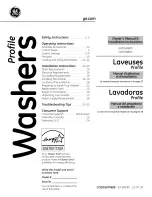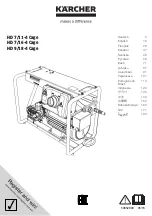
SK125
© NØRSE
9
© NØRSE
English
The following cleaning procedure will ensure that you achieve the most beneficial results in the shortest
amount of time.
Surface preparation
Clear the working area and make sure that all windows and doors are closed tightly. Make sure that all
plants and trees adjacent to the cleaning area are protected by a drop cloth.
Initial high pressure rinse
The next step is to spray the cleaning surface with water to clear off any dirt or grime that may have
collected on the surface. If you use detergent, this will allow your detergent to attack the dirt that has
worked its way into the cleaning surface. Before triggering the gun, adjust the nozzle to a wide spray
pattern and slowly adjust to the desired spray pattern. This will help you avoid applying too much
pressure to the surface that could cause damage.
Detergent application
Only use detergents formulated for pressure washers. Test the detergent in an inconspicuous area before
use. Follow the manufacturer’s label directions for mixing the correct concentrations of detergent to
water.
4.
Never store the pressure washer outdoors or where it could freeze. The pump will be seriously
damaged. Any components with water left inside will also be damaged, e.g. the pressure gun.
5.
Release the trigger when changing the spray pattern. Failure to do so could result in damage.
6.
Do not operate the pressure washer with the inlet water screen removed. Be sure to keep the
screen clear of debris and sediment.
7.
Make sure you clean the machine every three months and inspect the filter and the nozzle prior
to every use, ensuring there is no debris that may impair use.
Drawing from a barrel
First ensure the machine is switched off before connecting / disconnecting any hoses or attachments.
Instead of attaching the hose from pump to tap, use the supplied hose and filter set placing the filter end
in the water supply.
It is advised that the water supply is on the same level as the washer. If you struggle to get initial suction,
remove the outlet hose from the pump and try drawing again - this reduces the pressure on the pump
making it easier to draw. Once flowing, turn engine off and reconnect outlet hose before re-starting.
1.
Unscrew the top of detergent tank and fill with detergent.
2.
Put the top of detergent applicator back on.
3.
Set variable nozzle to detergent feature.
4.
Apply the detergent so it thoroughly covers the cleaning surface. Apply from bottom to top to
prevent the detergent from sliding down and streaking.
5.
Allow the detergent to remain on the surface for a few minutes. This is a good time to use a
brush to lightly scrub heavily soiled areas. Never allow detergent to dry on the cleaning surface.
6.
Rotate the variable nozzle from the detergent setting to the wide angle fan spray.
7.
Rinse detergent from surface.
8.
Rinse the detergent tank with clean water following each use.
9.
Final rinse
.
Make sure you thoroughly rinse the surface and that all detergent has been removed.
Shut down
1.
Make sure all detergent is flushed from the system.
2.
Turn off the motor.
3.
Turn off the water supply.
4.
Trigger the spray gun to de-pressurise the system.
5.
After each use, wipe all surfaces of the pressure washer with a clean, damp cloth.
Ø13
Summary of Contents for SK125
Page 6: ...SK125 NØRSE 6 English 07 08 09 10 11 12 13 D A t A W s t i A D N d T 1 2 3 L 1 2 3 G 01 14 15 ...
Page 22: ...SK125 NØRSE 22 Français 07 08 09 10 11 12 13 01 14 15 D U n A L C e L É L d d C 1 2 3 E 1 2 N ...
Page 27: ...SK125 27 NØRSE Français ...
Page 38: ...SK125 NØRSE 38 Deutsch 07 08 09 10 11 12 13 01 14 15 A E z W W W d D V S O R F 1 2 3 B 1 2 A ...
Page 43: ...SK125 43 NØRSE Deutsch ...
Page 54: ...SK125 NØRSE 54 Italiano D U s A Q c d L E P s f I 1 2 3 C 1 2 P 07 08 09 10 11 12 13 01 14 15 ...
Page 59: ...SK125 59 NØRSE Italiano ...
Page 70: ...SK125 NØRSE 70 Español 07 08 09 10 11 12 13 01 14 15 D O l Á C s i E E E s s P 1 2 3 C 1 2 L ...
Page 75: ...SK125 75 NØRSE Español ...










































